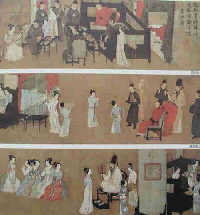 Traditional Cartoons
Traditional Cartoons
|

|
|
Han Xizai Ye Yan Tu
|
Cartoons actually are deeply rooted within China's long history, as Chinese glyphs (written Chinese characters) are based on drawn pictures.
A famous Chinese painting named "Han Xizai Ye Yan Tu" (Han Xizai's Night Banquet), dating back to the 10th century, is composed of five consecutive pictures that vividly reflect the luxurious nightlife of ancient Chinese Government officials. Thus the painting complies with the basic definition of a cartoon (a series of pictures telling a story; a comic strip).
However, although the Chinese cartoon existed in ancient times, it did not grow into an independent painting style until at the end of the Qing Dynasty (1644-1911).

In May 1925, Feng Zikai, considered to be China's cartoon master, started to publish his drawings at "wen xue zhou kan" (what is this?). His works were marked with the inscription "cartoon," marking the first time that the name of "cartoon" appeared to the public in China. From then on, various forms of cartoons spread all over the main streets and small alleys in China.
China's cartoon publications entered its peak in the 1930's. Many large-scale publications like Times Cartoon and China Cartoon welled up. At the same time, with the introduction of foreign cartoon books, China's cartoonists started to learn, drawing cartoon series and creating some famous characters. Ye Qianyu's "Mr Wang," Peng Di's "Master Q," and Zang Leping's "San Mao series" were all the representatives during that period.
The cartoons in that period reflected people's real life, exposing and satirizing the old China's various forms of corruption and darkness, while advocating democracy and the latest trend. In short, the artists promoted cartoons into a treasure in Chinese drawing art, with the cartoons having a very important status in China's modern drawing history.
